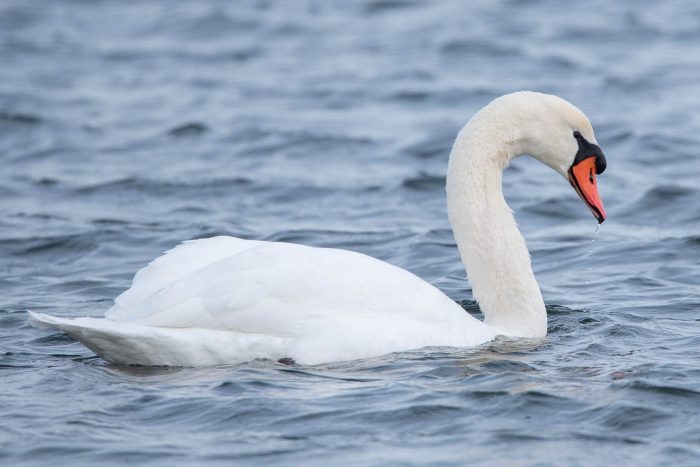Mute Swan
Cygnus olor
The mute swan is a large, white bird that lives on shallow waters throughout the Chesapeake Bay region. It is an invasive species.
This section shows one large critter image at a time. Use the thumbnails that follow to select a specific image to display here.

This gallery contains a grid of small thumbnails. Selecting a thumbnail will change the main image in the preceding section.
Appearance
The mute swan has a white body and a long neck that is held in a graceful S-curve. It has an orange bill with a black knob at the base and black to grayish-pink legs and feet. Mute swans grow to five feet long with a wingspan of seven to eight feet and weigh up to 25 pounds.
Feeding
The mute swan eats underwater grasses such as eelgrass and widgeon grass. It pulls out the whole plant, including roots and rhizomes. Adults eat more than eight pounds of underwater grasses every day. They feed by submerging their head and neck underwater, sometimes “tipping up” their tail in the process. During the winter, they will also eat wheat and other grains from farm fields.
Predators
Mute swans have no natural predators in the Chesapeake Bay watershed.
Flight
The mute swan holds its neck stretched straight ahead. It often flies in pairs or small groups.
Voice
Usually silent, but utters hissing and barking notes. A loud trumpeting call is rarely heard and the wings make loud whirring sound in flight.
Reproduction and life cycle
Mute swans begin breeding by their third spring. The female builds a large nest of down and marsh grasses close to the water. The female lays four to 10 light gray or bluish-green eggs that hatch in about 35 days and produce an average of six young, called cygnets. While the female is incubating her eggs and when cygnets are young, the male is very territorial and protective of the nest. It will hiss at and chase away intruders, including humans and other birds. Cygnets are brownish-gray and lack the black knob at the base of their bills. They turn all white by their second year. Parents chase their young out of the nest before the next breeding season begins. Mute swans usually live less than 10 years in the wild.
Did you know?
- Mute swans are the largest bird in the Chesapeake Bay region.
- They were introduced to the Bay region in 1962 when five mute swans escaped from an estate in Talbot County, Maryland.
- Mute swans can be confused with native tundra swans. You can distinguish a mute swan by its orange bill and gracefully curved neck. Also, mute swans live in the Bay region year-round, while tundra swans only visit in winter.
Sources and additional information
- Life in the Chesapeake Bay by Alice Jane Lippson and Robert L. Lippson
- Cygnus olor – Global Invasive Species Database
- Aquatic Invasive Species in the Chesapeake Bay: Mute Swan – Maryland Sea Grant
